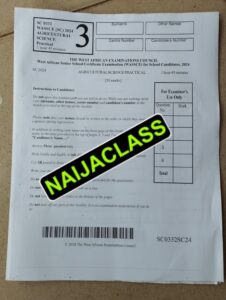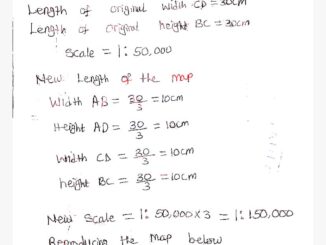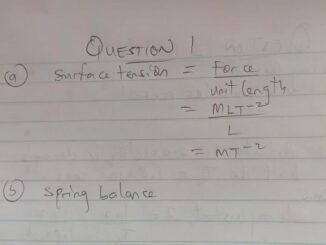Welcome to “Naijaclass Academy” For Waec 2024 Expo For Agric Science Practical Answer

Date: Tuesday, 14th May, 2024
Agricultural Science 3 (Practical) 9:30 am. – 11:00 am. (1st Set)
——————————
(1a)
A ranging pole is a robust, often brightly colored pole used primarily in surveying and construction to mark positions and sight lines. Typically, these poles are made from wood or metal, and they are painted in alternating bands of red and white or black and white to ensure high visibility over long distances. Ranging poles usually measure about 2 to 3 meters in length and may be equipped with a pointed end to easily stick them into the ground.
(1b)
(i)Spec A; ranging pole is primarily used to establish sight lines and mark positions on a site during surveying.
(ii)Spec B; An arrow in surveying is a small metal pin that is used to mark positions on the ground where measurements are taken.
(iii) Spec C; A measuring tape is a flexible ruler used to measure distance or size.
(iv)Spec D; A wooden peg is often used to permanently mark the boundaries of surveyed land.
(1c)
Coming!!!!!!
(1d)
(i) Regularly clean the poles after use to remove dirt and mud that can obscure the visibility of the markings.
(ii) Clean arrows of dirt and rust regularly to prevent deterioration.
(iii)After each use, clean the tape by pulling it through a clean rag to remove any dirt, mud, or debris that might have accumulated.
(iv)Before use, ensure that the wooden pegs are dry and free from cracks.

==================================
OR
1(a) Specimen A is a ranging pole, which is a long, straight, and sturdy rod used in surveying and measuring distances. It is typically made of wood, metal, or fiberglass and has markings or graduations indicating units of measurement.
1(b)
– Specimen A (Ranging pole): Measuring distances and determining boundaries.
– Specimen B (Arrow): Pointing or indicating directions.
– Specimen C (Measuring tape): Measuring lengths or distances.
– Specimen D (Wooden peg): Marking or securing points or boundaries.
=======================
WAEC AGRIC PRACTICAL
NUMBER TWO
(2a)
The aim of the experiment is to determine the capillary rise of water in dry sand, dry clay, and dry loam.
(2b)
E: Least rise
F: Moderate rise
G: Highest rise
(2c)
(PICK TWO ONLY)
(i) The rise is influenced by soil type.
(ii) Loam has the highest capillary rise due to its texture.
(iii) Clay exhibits moderate capillary action.
(iv) Sand shows the least capillary rise.
(v) Soil particle size affects capillary action.
(vi) Water retention varies with soil composition.
(2d)
(PICK ONE ONLY)
(i) Prevents soil particles from escaping.
(ii) Acts as a barrier to maintain separation.
(iii) Facilitates water absorption evenly.
(iv) Maintains consistency in the experiment setup.
(v) Absorbs excess water to avoid spillage.
(2ei)
The soil in the capillary tube labelled E is best for agriculture.
(2eii)
(PICK TWO ONLY)
(i) Good drainage properties that prevent waterlogging and allow for proper aeration of plant roots.
(ii) High permeability that allows roots to easily penetrate the soil for nutrient uptake.
(iii) Low water retention which helps prevent root rot in plants.
(iv) Easy cultivation and good soil structure for root growth.
(v) Suitable for crops that require well-drained soil conditions.
(vi) Less prone to compaction, promoting healthy root development.
(2f)
Draw the diagram
===========================================
====================================
WAEC AGRIC PRACTICAL
NUMBER THREE
(3a)
H: Chewing mouthparts
J: Chewing mouthparts
K: Piercing-sucking mouthparts
(3b)
SPECIMEN H:
(PICK THREE ONLY)
(i) Destroys maize grains
(ii) Reduces grain quality
(iii) Causes economic losses
(iv) Decreases yield
(v) Spoils stored maize
(vi) Increases susceptibility to diseases
(vii) Damages maize seeds
SPECIMEN J:
(PICK THREE ONLY)
(i) Feeds on crop leaves
(ii) Causes defoliation
(iii) Reduces plant growth
(iv) Decreases crop yield
(v) Contributes to soil erosion
(vi) Indirectly affects other organisms in the ecosystem
(vii) Hinders crop development
(3c)
(PICK THREE ONLY)
(i) Proper storage hygiene
(ii) Temperature control
(iii) Fumigation
(iv) Use of insecticides
(v) Regular monitoring and inspection
(vi) Sealing storage containers tightly
(3d)
(PICK THREE ONLY)
(i) Soybeans
(ii) Okra
(iii) Beans
(iv) Red clover
(v) Peanuts
(vi) Sunflower
OR
(3a) H: Chewing mouthparts.
J : Chewing mouthparts.
K: Piercing and sucking mouthparts.
(3b)
Effects of Specimen H on crop production:
(PICK ANY THREE)
(i) Damage to stored maize grains.
(ii) Reduction in grain quality and quantity.
(iii) Economic losses to farmers and storage facilities.
(iv) Risk of mycotoxin contamination due to fungal growth facilitated by weevil infestation.
(v) Decreased market value of infested maize.
Effects of Specimen J on crop production:
(PICK ANY THREE)
(i) Defoliation of plants
(ii) Reduction in crop yield
(iii) Damage to young seedlings
(iv) Increased plant susceptibility to diseases
(v) Decreased quality of harvested produce
(3c)
(PICK ANY THREE)
(i) Proper sanitation by keeping the store clean and free from spilled grains.
(ii) Regular inspection of stored maize for signs of infestation.
(iii) Use of hermetic storage methods such as airtight containers or bags to suffocate the weevils.
(iv) Application of chemical insecticides approved for grain storage, following recommended dosage and safety precautions.
(v) Employing physical control measures such as freezing or heating the infested maize to kill the weevils and their eggs.
(3d)
(PICK ANY THREE)
(i) Okra
(ii) Hibiscus
(iii) Eggplant
(iv) Bell peppers
(iv) Tomatoes
`








I need to get the pin but how can i do to register online
HOW CAN I GET THE PIN
God help every one
Yes
It’s good
We need it urgently drop it so fast
sure
I need english language pin pls for tomorrow examination 15/may/2024
KEEP IT UP
Same
Good job
I need English language WAEC 2024
I need agricultural science pin today please
I need English language pin pls for tomorrow bpapet
God haip them all
I need English answers pls
The answer are correct
pls can we get the English language question for theory before 6am Thanks
I need agriculture objective please tomorrow
I need agriculture objective please tomorrow
I need agric objective answer please thank you
I need the chemistry practical and agriculture essay and objectives pin please